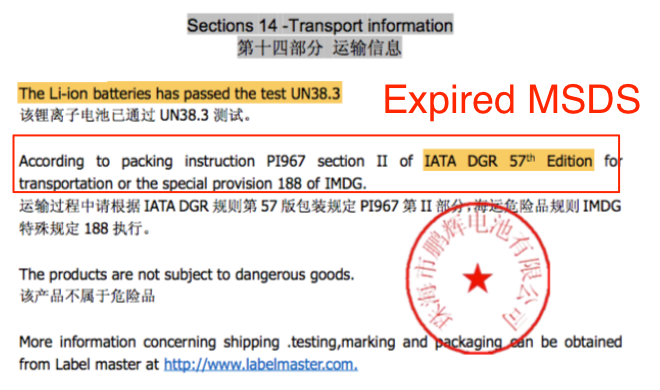Glossary
MSDS (Material Safety Data Sheet)
Tags:
An MSDS will be required for all dangerous, or even just potentially dangerous, shipments. The supplier is responsible for providing all hazmat documentation.
MSDS (Material Safety Data Sheet)
What is an MSDS?
An MSDS (Material Safety Data Sheet) is a document containing information about the potential hazards of a product, and how to safely handle it. An MSDS is required for all potentially dangerous products and all lithium battery shipments (whether dangerous or not). An MSDS may also be required for potentially dangerous products, like liquids, creams, and powders, just to prove that they aren’t dangerous. Carriers may also request an MSDS for dry or alkaline batteries, to certify they are not lithium based.
Flexport will need a copy of the MSDS before beginning the shipment. Before uploading the MSDS into the app, check that the MSDS isn’t expired.
How do I know if an MSDS is expired?
To check whether or not an MSDS is expired, go to Section 14, “Transport Information,” and look for what edition of IATA DGR (International Air Transport Association Dangerous Goods Regulations) the products were packaged according to:

Note that the look of an MSDS may differ per supplier, but every MSDS will be divided into sections.
As of January 1st, 2018, the latest edition of IATA DGR is the 59th edition. If the products have been packaged according to any edition before the 59th, the MSDS is expired.
IATA releases the next year’s edition of the DGR in October of every year, before it goes into effect January 1st. IATA will release the 60th edition of the DGR in October of 2018, so suppliers should begin adhering to the new edition in October before it goes into effect on January 1st of 2019 to avoid any shipment delays with an outdated MSDS.
Can I re-use an MSDS?
The same MSDS can only be used for recurring shipments if the hazardous material is exactly the same. For example, you can use the same MSDS for a lithium battery in many different types of products as long as the same lithium battery is being used. The MSDS will still need to be provided for every single shipment to certify that the hazardous material has not changed.
It is the sole responsibility of the shipper to properly package, label, document, and prepare all documentation necessary to ship a potentially dangerous item.
Learn More
Related Help Articles
Shipping Hazardous Materials and Other Dangerous Goods
Hazardous Materials and Hazmat Regulations: The Basics
Resources
Dangerous Goods Regulations - IATA
